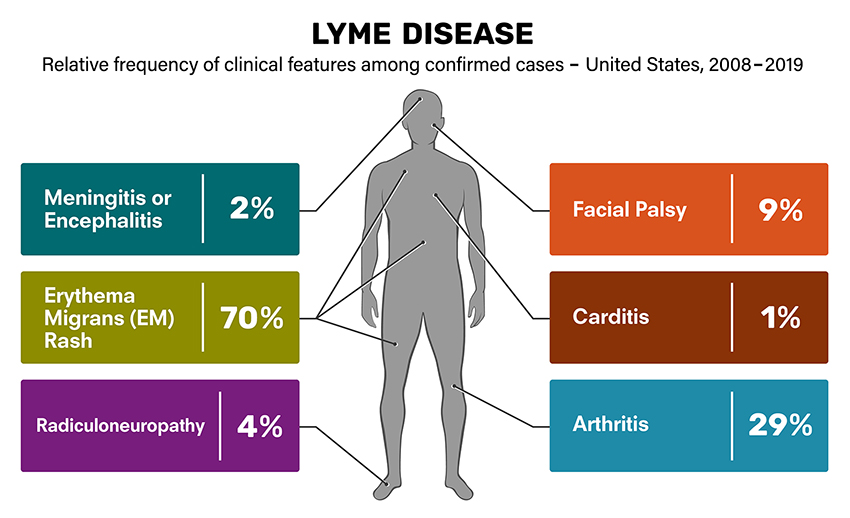Questions and Answers About Lyme Disease
![]()
Q. How do people get Lyme disease?
A. From being bitten by a tick infected with Lyme disease bacteria – the bacterium is named Borrelia Burgdorferi and is most often carried by deer. (Deer tick) It is actually the feces of the bacteria that make a person sick. This was told to me by an Infectious Disease physician at Yale University, USA
![]()
Q. What is the basic transmission cycle?
A. Immature ticks become infected by feeding on small rodents, such as the white-footed mouse, and other mammals that are infected with the bacterium Borrelia burgdorferi. In later stages, these ticks then transmit the Lyme disease bacterium to humans and other mammals during the feeding process. Lyme disease bacteria are maintained in the blood systems and tissues of small rodents.
![]()
Q. Can you get Lyme disease from another person?
A. No! Lyme disease bacteria are NOT transmitted from person-to-person. For example, you cannot get infected from touching or kissing a person who has Lyme disease, or from a health care worker who has treated someone with the disease, or by sexual contact.
![]()
Q. What are the signs and symptoms of Lyme disease?
A. Within days to weeks following a tick bite, 70% of patients will have a red, slowly expanding “bull’s-eye” rash (called erythema migrans), accompanied by general tiredness, fever, headache, stiff neck, muscle aches, and joint pain. If untreated, weeks to months later some patients may develop arthritis, including intermittent episodes of swelling and pain in the large joints; neurologic abnormalities, such as aseptic meningitis, facial palsy, motor and sensory nerve inflammation (radiculoneuritis) and inflammation of the brain (encephalitis); and, rarely, cardiac problems, such as atrioventricular block, acute inflammation of the tissues surrounding the heart (myopericarditis) or enlarged heart (cardiomegaly). BTW, there is some discrepancy over how many people actually develop the “bull’s-eye” rash.
![]()
Q. What is the incubation period for Lyme disease?
A. For the red “bull’s-eye” rash (erythema migrans), usually 7 to 14 days following tick exposure. Some patients present with later manifestations without having had early signs of disease. Most people feel weak or tired about 10 days to two weeks after being bitten.
![]()
Q. Can a person be reinfected with Lyme disease?
A. Of course. Having had Lyme disease doesn’t protect against reinfection. Some persons have had Lyme disease more than once after exposure to infective tick bites. You can get bitten every year if you are not careful enough. This stresses the need for continued tick bite prevention activities such as wearing appropriate clothing when in tick-infested areas, daily tick checks, and quick removal of attached ticks. (I knew a man who had it ten times, he was a gardener. I had it twice).
![]()
Q. How is Lyme disease treated?
A. According to treatment experts, antibiotic treatment for 3-4 weeks with doxycycline or amoxicillin is generally effective in early disease. Cefuroxime axetil or erythromycin can be used for persons allergic to penicillin or who cannot take tetracyclines. Later disease, particularly with objective neurologic manifestations, may require treatment with intravenous ceftriaxone or penicillin for 4 weeks or more, depending on disease severity. In later disease, treatment failures may occur and retreatment may be necessary.
![]()
Q. Is the disease seasonal in its occurrence?
A. Yes, Lyme disease is most common during the late spring and summer months in the U.S. (May through August) when nymphal ticks are most active and human populations are frequently outdoors and most exposed. BUT, in some areas of the northeast the ticks do not die in winter.
![]()
Q. Where is Lyme disease most prevalent?
A. See map on Lyme Disease page. Generally, most Lyme disease is endemic in the northeastern and upper midwest states. There is also Lyme Disease in Europe too, this is not just a disease in the United States. The deer that carry the deer-tick are also in other countries.
The vast majority of cases of Lyme disease occur in New York, Connecticut, Pennsylvania, and New Jersey. Other states where the disease is prevalent include Massachusetts, Wisconsin, Rhode Island, Maryland, Minnesota, and Delaware.
The prevalence of Lyme disease in the northeast regions of the United States is due to the presence of large numbers of the deer ticks’ preferred hosts, which include white-footed mice and deer and their close proximity to humans. Persons in endemic areas who are frequent visitors to grassy, wooded locations inhabited by white-tailed deer and mice in the Northeast and upper Midwest states and along the Northern Pacific coast of California, are at greatest risk for getting Lyme disease.
